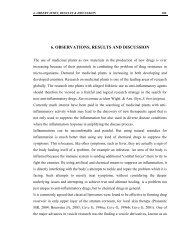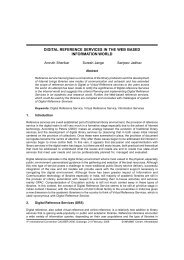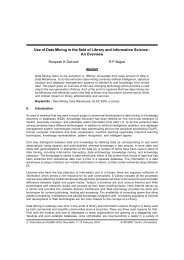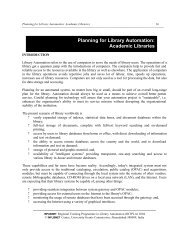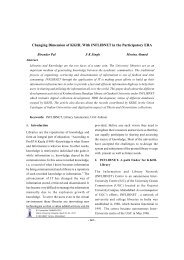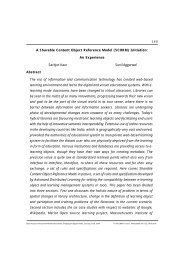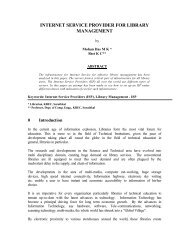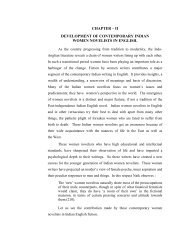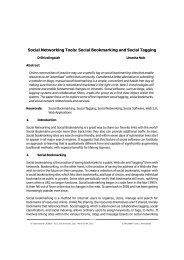knowledge management through technologies and professionals
knowledge management through technologies and professionals
knowledge management through technologies and professionals
Create successful ePaper yourself
Turn your PDF publications into a flip-book with our unique Google optimized e-Paper software.
118expertise wherever it resides <strong>and</strong> distributing it whenever needed to help produce the biggestpayoffs. Indeed, K is of limited organizational value if it is not shared. Therefore, KM objectiveshould be derived from organizational goals. KM success includes creativity, innovativeness,adaptability, sharing <strong>and</strong> reacting to changes. (12)3. Knowledge Sharing (KS)The crucial outcome of KS is the creation of new K <strong>and</strong> innovation that will significantly improveorganizational performance. KS in its broader sense refers to the communications of all types of K,which includes explicit <strong>and</strong> tacit <strong>knowledge</strong>. Therefore, KS activity is crucial for organizationalsuccess because, many industrial nations today are faced with an ageing population, implying agraying workforce for many organizations. This has led to the requirement that the K that they haveaccumulated over the years they codified in some form <strong>and</strong> “passed on” before they retire. Aprominent model has suggested by Nonanka <strong>and</strong> Takeuchi for the effective KS. They proposed theK spiral model that is concern with the conversion of tacit K to explicit K <strong>and</strong> vice versa. They alsosuggested four steps: Socialization, Externalization, Combination <strong>and</strong> Internationalization (SECI)by which KS can take place. (9)4. Information <strong>and</strong> KnowledgeInformation is data that has been processed into a meaningful form. Seen in this way, informationis an assemblage of data in a comprehensible form capable of communication <strong>and</strong> use; the essenceof it is that a meaning has been attached to the raw facts. The conceptual distinction betweeninformation <strong>and</strong> <strong>knowledge</strong> is therefore rather unclear, although the two terms tend to be used insomewhat different contexts. Increasingly, information is the word that is applied in the broadprofessional <strong>and</strong> technical contexts represented in such phrases as ‘Information Technology’ or‘Information retrieval’ or ‘Information Management’. It is thus used in general sense to encompassall the different ways of representing facts, events <strong>and</strong> concepts in both digital <strong>and</strong> analog systems,<strong>and</strong> in all media <strong>and</strong> systems. (5)Knowledge is information evaluated <strong>and</strong> organized in the human mind so that it can be usedpurposefully. In this sense, the term can be equated with underst<strong>and</strong>ing. Again, The Knowledge isdefined as a fluid mix of framed experience, values, contextual information <strong>and</strong> expert insight thatprovides a framework for evaluating <strong>and</strong> incorporating new experiences <strong>and</strong> information. It originates<strong>and</strong> is applied in the minds of knowers. In organizations, it often becomes embedded not only indocuments or repositories but also in organizations routines, processes, practices <strong>and</strong> norms. Asinterest grows beyond information, calculation & imagination organization are looking to technologyto progress toward the development of KM systems. The development of technology has taken thedrudgery out of searching, analyzing <strong>and</strong> converting data into information to which K can be applied.Technology <strong>and</strong> <strong>knowledge</strong> however do not st<strong>and</strong> in isolation. The organization that promotes thevalue of K, skills <strong>and</strong> competencies of its people <strong>and</strong> recognizes the importance of technology is
119providing well for its future. (2)5. Differences in emphasis between KM <strong>and</strong> Traditional Library & Information work6. Virtual LibraryEvery college department <strong>and</strong> individual lecturers archive material in the form of journals <strong>and</strong>books related to specific topics. However, few systems to track departmental <strong>and</strong> individualrepositories to facilitate research <strong>and</strong> budgeting. This component will do the following:• Track research material within departments.• Automate the lending of research materials to staff <strong>and</strong> students.• Enable inventory <strong>and</strong> budget reporting.• Assist lecturers in managing their personal resources (Journals, books <strong>and</strong> proceedings).• Eliminate duplicate purchase of material.• Reduce the workload of administrative <strong>and</strong> academic staff. (4)7. Knowledge Management System (KMS)A comprehensive Information & Communication Technology (ICT) platform for collaboration <strong>and</strong>Knowledge Sharing, with advanced <strong>knowledge</strong> services built on top that are contextualized <strong>and</strong>
120integrated on the basis of a shared ontology, <strong>and</strong> personalized for participants networked incommunities. KMSs foster the implementation of KM instruments in support of <strong>knowledge</strong> processestargeted at increasing organizational effectiveness. (10)Information system can include either operative or directive <strong>and</strong> decision support information.Operative system provide system users with information necessary in workers’ daily work, whiledirective <strong>and</strong> decision support systems provides system users with information that improves thequality of decision workers make in daily work. KMSs are system developed to manage K directlyor indirectly to give support for an improved quality of a decision made in worker daily work, <strong>and</strong> asan extension, an increased organizational ability. A KMS typically includes the directive informationfor example, in guiding user’s choice in a specific work situation. Such systems are often optionalin the sense that users can deliberately refrain from using the systems <strong>and</strong> / or refrain from takingthe directed action. Accordingly, users acceptance is crucial for the degree of usage of KMS. (1)8. Knowledge Management Education (KME)Against a great deal of debate about the future of information <strong>professionals</strong> on the one h<strong>and</strong> <strong>and</strong>KM as a profession on the other, the core educational issues relating to the skill <strong>and</strong> competenciesthat professional needs to acquire in order to provide effective solutions to the problems associatedwith KM. As K becomes a key strategic input, there is a need to have a broader underst<strong>and</strong>ing ofthe various KM processes that include K creation, capture, retention <strong>and</strong> transfer of <strong>knowledge</strong>sharing. As KM is a multidisciplinary profession, K <strong>professionals</strong> need to have a broader educationthat enables them to deal with a complex technological environment <strong>and</strong> the large amount ofinformation generated every day, to encourage <strong>and</strong> promote K sharing activities <strong>and</strong> to ensure thatthe information <strong>and</strong> K acquired by the library is properly utilized <strong>and</strong> translated in to products <strong>and</strong>services.9. Role of Human Resource Management (HRM) in Knowledge Management (KM)Though Knowledge Managers can put system in place but it is the manpower <strong>and</strong> willingness onthe part of manpower to share the tacit K that enables KM systems to work effectively. The motivationthat contribute the K with the organization depends on the levels of the commitment of the workershave towards the organization <strong>and</strong> their perception about own role in the organization. Unless theyare committed to the organization <strong>and</strong> strongly hold the feelings that both themselves <strong>and</strong> organizationare complementary to each other, effective KM system will not work. Success of any KM initiativeslargely depends on level of motivation of people <strong>and</strong> their subsequent active role in KM process.Most of the Knowledge in the organization is tacit in nature, though some people do not agree withthe dichotomous classification of the K as either Tacit or Explicit. Tacit <strong>knowledge</strong>, either embrainedor embodied is possessed by people <strong>and</strong> is often found difficult to codify it into explicit form. K isa resource occurred in human mind. So, the personal nature of the tacit Knowledge requires willingnesson the part of the workers to share <strong>and</strong> communicate with others.
12110. Building employee Commitment <strong>through</strong> HRM InitiativesEffective KM largely depends on the employee motivation <strong>and</strong> commitment towards the organization.Employee commitment is found to be associated with other constructs like trust, psychologicalcontracts <strong>and</strong> job satisfaction. Guest <strong>and</strong> Conway’s model attempts to integrate constructs likecommitment psychological contracts <strong>and</strong> job satisfaction. Psychological contracts represent theperceptions both the employee <strong>and</strong> the organization bring to the employment relationship of theirinternal obligations. Commitment to organization is an attitudinal consequence of the psychologicalcontracts. A positive psychological contract means a positive / higher levels of commitment havetheir bearing on the behavioral consequences. Workers with high level of organizational commitmentare less likely to leave, are more likely to be highly motivated <strong>and</strong> will be more willing to provideextra discretionary effort <strong>and</strong> be generally willing to share their K within the organization. There arefive perspectives, which can be used to link HRM with KM. The perspective of ‘best practices’facilitates KS <strong>and</strong> these practices can be used for any organization. Development, use <strong>and</strong> retentionof <strong>knowledge</strong> capital in organizations are to some extent dependent on workers possessing somelevel of commitment to the organization in which they were working. So, HRM practices <strong>and</strong> policiesplay a role in deciding the employee commitment <strong>and</strong> motivation to share the <strong>knowledge</strong> within theorganization. (7)11. The Role of Technology in KMThough KM is not about technology, it plays an important role in KM. The advances in Information<strong>and</strong> Communication Technology (ICT), the Internet revolution <strong>and</strong> the move toward information <strong>and</strong>K Society have emphasized the importance of K <strong>and</strong> the need for KM. Besides, InformationTechnology (IT) has improved the ability to store, access, manipulate <strong>and</strong> use of information in avariety of ways. However, technology cannot m<strong>and</strong>ate human collaboration. If effectively used, itcan only streamline work operations <strong>and</strong> improve communication between people. Collaborativeapplications such as e-mail, calendaring, scheduling, databases <strong>and</strong> threaded discussions promoteK sharing <strong>and</strong> K transfer. Information <strong>management</strong> is only one component KM given that KMinvolves many human factors associated with K.KM tools need to go beyond information <strong>management</strong> activities <strong>and</strong> focus on tools that will enablehuman communications <strong>and</strong> collaboration. This is because information <strong>management</strong> tools are onlyconcerned with the <strong>management</strong> of explicit K <strong>and</strong> include tools for capturing, indexing, retrieving,<strong>and</strong> manipulating information where as KM <strong>technologies</strong> go beyond information <strong>management</strong> toolsto include <strong>technologies</strong> designed to facilitate the <strong>management</strong> of other types of <strong>knowledge</strong> such astacit <strong>knowledge</strong>. These <strong>technologies</strong> require human interactions at all levels <strong>and</strong> their main objectiveis to facilitate communication, collaboration <strong>and</strong> interaction that in turn will facilitate K transfer fromone person to the other. (8)
12212. Technology: Enabler or Value-Adder?The organizations of world wide networks <strong>and</strong> new technology is “the catalyst which is forcing allorganizations to re-evaluate what they know, what they do with that <strong>knowledge</strong> <strong>and</strong> how theycontinually add value to that Kin meeting changing <strong>and</strong> ever growing users need”. While the cost of“keeping up” with technological developments has always been a problem for organizations thathave made a strong commitment to technology, others recognize that they need to work smarterwith that they have. If technology is just an enabler, what is that adds value to the organizations?According to Binney, what has emerged is the KM spectrum, in which he identifies KM applications<strong>and</strong> places them into “six common categories to establish the elements of the KM Spectrum”.The mapped KM applications as per the elements are as;• Transactional - Order entry applications, help desk applications.• Analytical - Data warehousing, customer relationship, DSS,MIS. <strong>management</strong>,• Asset Management - Document <strong>management</strong>, Intellectual Property.• Process - TQM, process automation, benchmarking.• Developmental - Skill development & training.• Innovation & creation - Communities, Virtual teams, networking.The next stage of the process added to the various elements, enabling <strong>technologies</strong>:• Transactional - Expert system, probability networks.• Analytical - Intelligent agents, data analysis <strong>and</strong> reportingtools.• Asset Management - document <strong>management</strong> tools, Knowledge Maps.• Process - Workflow <strong>management</strong>, Process-modeling-tools.• Developmental - Computer based training, online training.• Innovation & creation - Search engine, Voice mail, Group ware.The KM spectrum provides organizations with the means to identify their present positions <strong>and</strong> tomake use of the framework to map their future investments in KM. The technology has provided theimpetus for the growth of the information age. But it should not be regarded as a domain partner.The future will bring ever more sophisticated advancements in technology providing new avenuesof exploration for seeking, creating <strong>and</strong> sharing <strong>knowledge</strong>. (3)
12313. The Web-Based Knowledge Management ModelsOne individual does not create the content of KMS. The content collection <strong>and</strong> the access of thecontent is a collective behaviour. Therefore, the technological infrastructure installed must be ableto facilitate the collective behaviour of KM. There are four web-based KM models. These modelsrepresent the current level of web-based KM. Nonetheless; these four types model may not representall of the web-based KM models. These four representative models are as:‣ Library model‣ Attachment / Association model‣ Directory model‣ Press center model.As the title of this paper in concern, out of the four above-mentioned models we like to highlightsonly the Library Model.Library ModelThis model enables content-based document searches. Under this model, a large collection ofdocument is established. Both the attributes <strong>and</strong> the content of a document are indexed, in contrastto the traditional method where only the attributes of a document are indexed. The attributes ofdocument may include title, subject, author name(s), publication (creation) date, number of pages<strong>and</strong> so on. Under this model powerful search functions are provided, where not only these attributesare searched, but also the content of the documents are searched. An example was provided bythe IT Knowledge.com web site, which is a large repository of IT related books. The contents of thebooks are fully available. The chapters in a book are hypertext documents. Not only the attributesof the books are classified <strong>and</strong> indexed <strong>and</strong> can be searched easily, but also the chapter titles arealso indexed by keyword <strong>and</strong> can be searched. This makes it possible to find a document withattributes. That does not meet a search criterion.(13)14. Library <strong>professionals</strong> in Knowledge ManagementThe roles of library <strong>professionals</strong> are increasing at rapid rate in the work of collection, organization<strong>and</strong> dissemination of information. Information is an essential component of the all round developmentof the society as a whole. So, to ensure the maximum use of information, enough attention bedevoted to the entire process from the information generation to its effective use. In <strong>knowledge</strong>production, information is used as input. Again, KM consisting of <strong>knowledge</strong> managers or<strong>professionals</strong> to perform the following functions as an Information:‣ Generators‣ Gatherers‣ Recorders
124‣ Processors‣ Organizers‣ Disseminators‣ Retrievers‣ Preservers‣ Measurers‣ Compilers(11)From the above, it is seen that the library <strong>professionals</strong> has to take number of responsibility to theentire KMS. Now, it is very much common to all of us that the application of Information Technology(IT) <strong>and</strong> even Information communication Technology (ICT) is indispensable due to the severalexplosions in information society (population explosion, information explosion, technologicalexplosion, <strong>knowledge</strong> explosion etc). Therefore, necessary steps (Education, Training, Orientation,Refresher, Workshop on continuing basis) are to be taken for the technological awareness (includingits frequent changes) among the library <strong>professionals</strong>, so that they can easily & cordially copethemselves with the changing environment. To motivate the library personnel recruitment <strong>and</strong>promotion is to be made on bias-free as well as on the basis of all the relevant factors takingtogether instead of individual factor. The factors are may be performance, efficiency, academicqualification <strong>and</strong> seniority as the case may be.15. ConclusionsIt should always be kept in mind the different factors associated with the relevant system(s) for theproper utilization of the data, information, <strong>and</strong> <strong>knowledge</strong> what ever it may be. Enough attention begiven for the development of the library personnel for the successful completion / execution of theplan of the organization. Unless otherwise performance development of the concerned personnelthe technology alone fails to achieve target objectives. It may be state that, optimum combinationof the entire component not only KMS rather any system is the helpful to cater the services as perthe dem<strong>and</strong> of the client. The main component of the KMS are Technology, Knowledge / information,Staff <strong>and</strong> Users. So, to run any <strong>knowledge</strong> organization in proper way it is essential to have requiredtechnological infrastructure, technologically sound staff, st<strong>and</strong>ard information / <strong>knowledge</strong> <strong>and</strong>conscious users community. To inform <strong>and</strong> update the <strong>professionals</strong> it is better to conduct thetraining <strong>and</strong> development programs after certain intervals <strong>and</strong> at the same time initiative is also tobe taken for offering periodic users learning programme to make them familiar with the presenttechnology.References1. Ericson, Fredrick & Avdic, Anders (2005). Knowledge Management Systems Acceptance.In Encyclopaedia of Information Science <strong>and</strong> Technology by Khosrow- Pour, Mehdi. London:
125Idea group reference, Vol-III, 1779p.2. Mitchel, Helen (2005). Technology <strong>and</strong> Knowledge Management. In Encyclopaedia ofInformation Science <strong>and</strong> technology by Khosrow- Pour, Mehdi. London: Idea group reference,Vol-V, 2749p.3. Ibid: 2751-52p.4. Neville, Karen & Powell, Philip (2005). Knowledge – Based Support Environment. InEncyclopaedia of Information Science <strong>and</strong> technology by Khosrow- Pour, Mehdi. London:Idea group reference, V-III, 1789-90p.5. Feather, John & Sturges, Paul (2003). International Encyclopedia of Information <strong>and</strong> LibraryScience. 2 nd ed. London: Routledge, 244p.6. Ibid: 357p.7. Rao, N Janardhan (2005). Knowledge Management Cultivating Knowledge Professionals(Book Review). In the ICFAI Journal of Knowledge Management. Hyderabad: ICFAI UniversityPress; Vol. III, No. 4, December 2005, 71p.8. Ibid: 72-73p.9. Khosrow-Pour, Mehedi (2006). Dictionary for Information Science <strong>and</strong> Technology. London:Idea group reference, V-II, 391p.10. Saha, N.C. & Das M. (2006). Human resource aspect in digital library era. In: ConferenceProceedings, PLANNER-2006 (INFLIBNET). Aizwal: Mizoram University, 210-221p.11. Sujatha, R (2007). Critical success factors for implementation of <strong>knowledge</strong> <strong>management</strong>.In the ICFAI Journal of Knowledge Management. Hyderabad: ICFAI University Press; Vol.V, No. 1, January 2007, 62p.ABOUT AUTHORSMr. Nimai Ch<strong>and</strong> Saha is Deputy Librarian, Central Library at Visva-Bharati, Santiniketan, W.B.He holds M.Com. M.L.I.Sc. B.Ed., from the University of Burdwan & D.C.P.A from TULEC <strong>and</strong>UGC – NET (June-2006). He has been college librarian for 7years <strong>and</strong> as Deputy librarian for1.5years running. Presently doing Research work as an External Scholar at the University ofBurdwan under the Supervision of Prof. S.C. Biswas.Mr. Mrinal Kanti Das is Libriary Professional, did his B.Sc., M.L.I.Sc. <strong>and</strong> D.Pharm. He has morethan five publication under his credit.Email : mkdlis@sify.com
126




